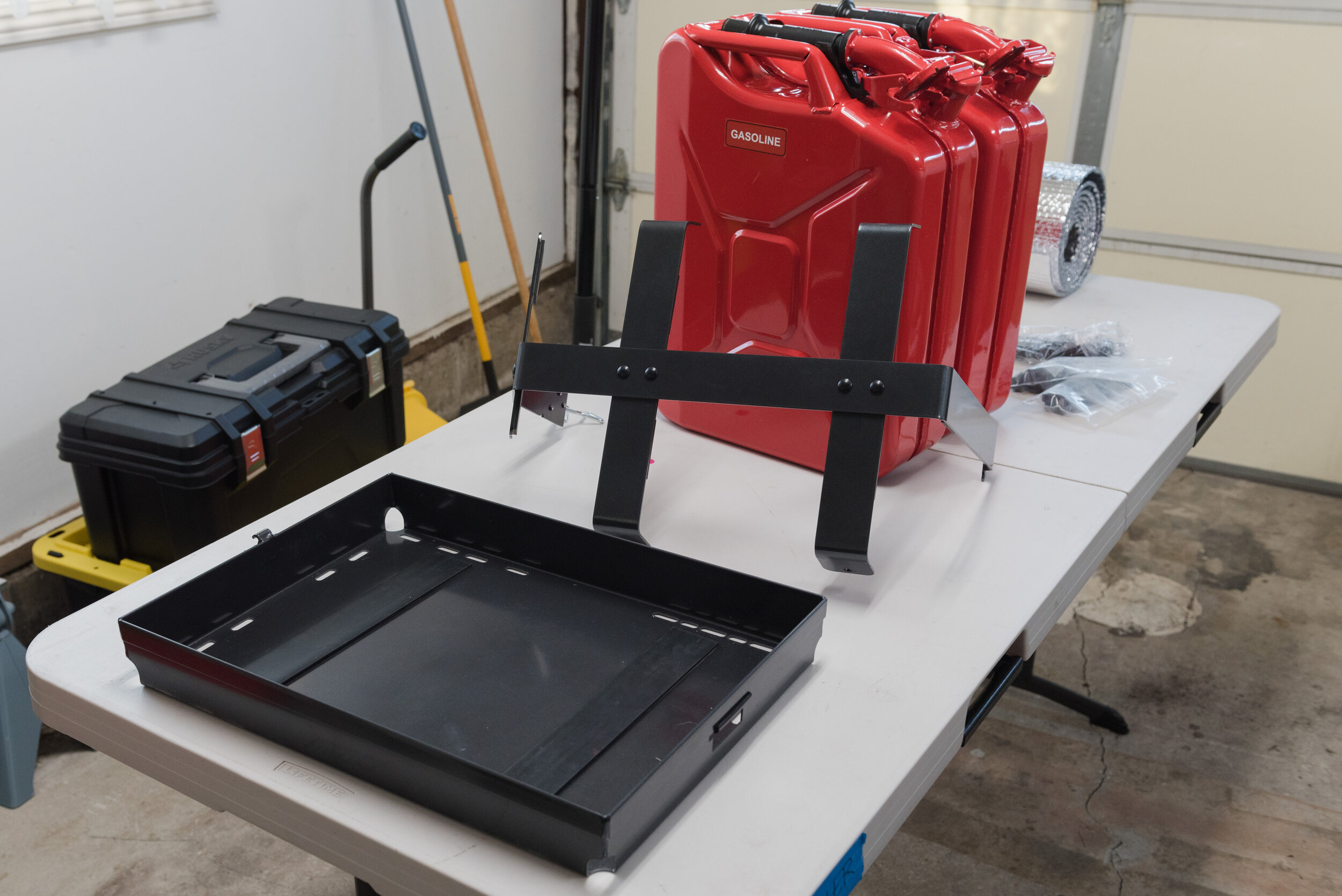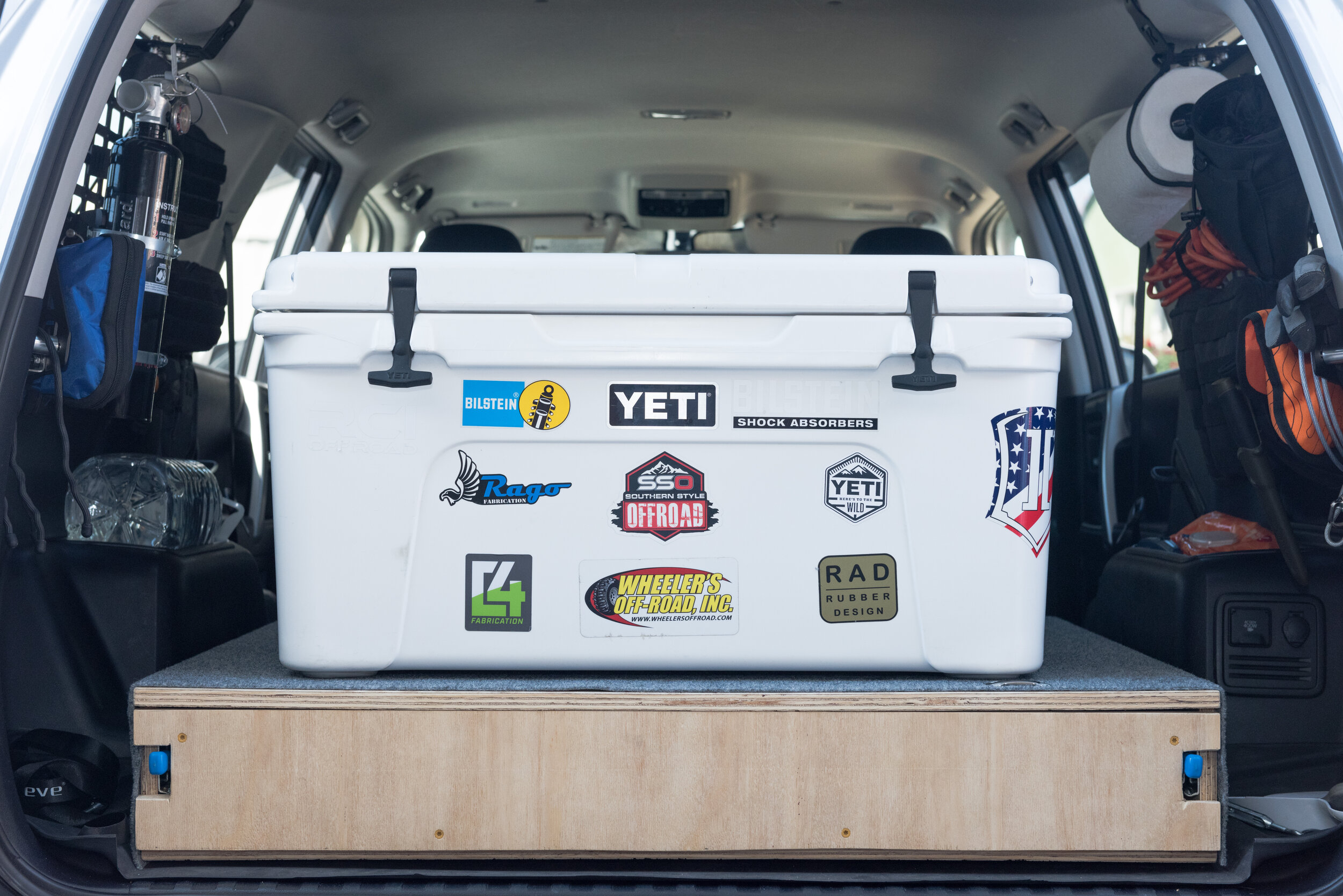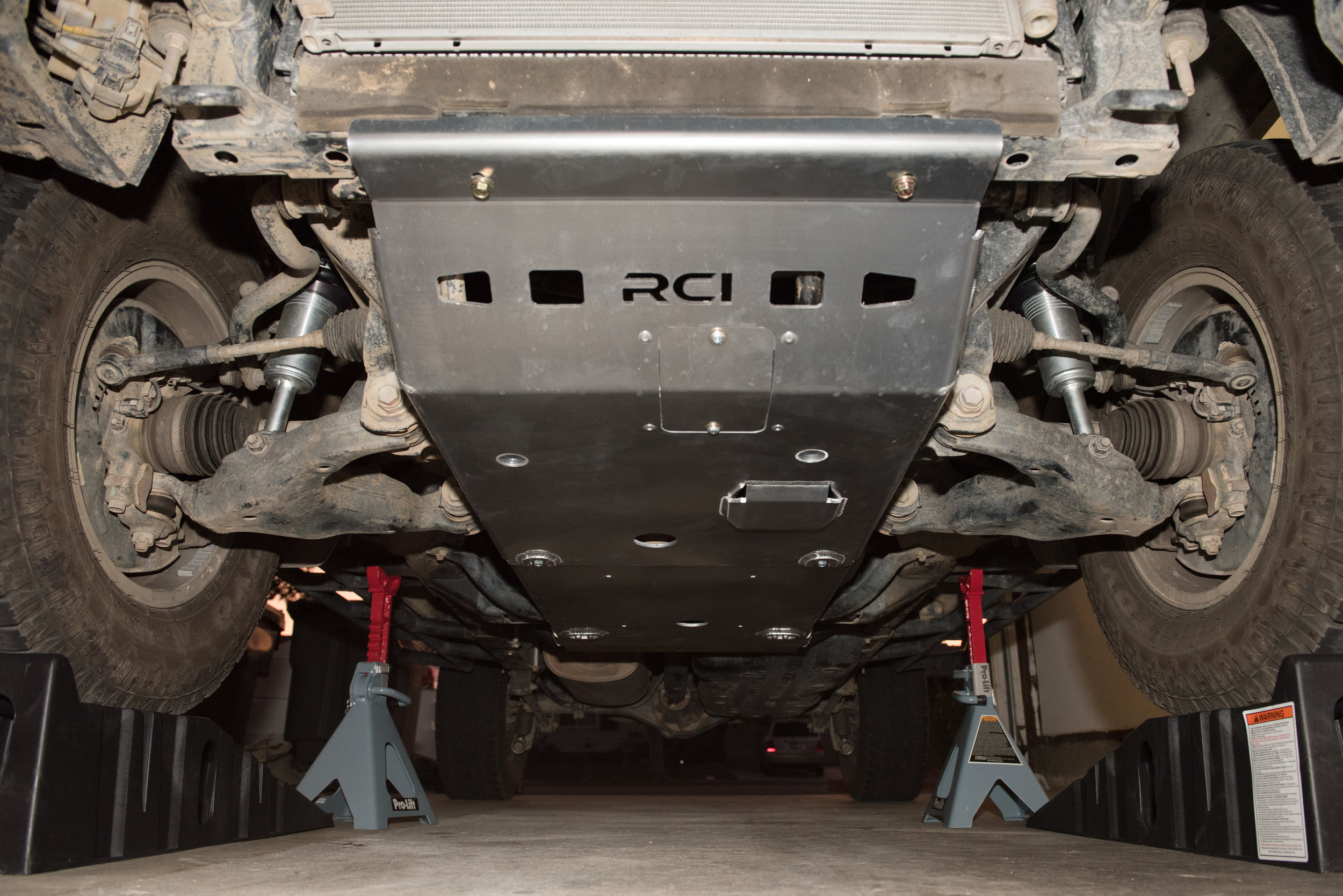After running always-available power to the trunk, installing an onboard refrigerator/freezer (ICECO JP40), and upgrading to an AGM battery, I started researching how to keep our main battery charged day-to-day on the road. A dual-battery setup was out of the question as I had already set aside the passenger-side firewall (where a second battery is usually installed) for an onboard air compressor.
Ultimately I decided on installing Cascadia 4x4’s Vehicle Specific Solar (VSS) System 90W Solar Panel for the 5th Gen 4Runner. What I really love about their system is that it makes use of otherwise unused hood space. Their system also incorporates a pre-cut vinyl base layer that is sized slightly larger than their solar panel to protect the hood’s paint. This is important since the solar panel sits on the hood and can vibrate as the vehicle moves, which could (in theory) damage underlying paint… not that I ever plan on taking it off - but hey, precautions, right? They also sell their own version of a Maximum Power Point Tracking (MPPT) Solar Charge Controller - though I opted for a different unit.
A solar charge controller is required to regulate the charging voltage/current and thereby keep the batteries from overcharging, which can not only permanently reduce battery life but could also result in the battery failing and a fire starting in your engine bay! There are two types of solar charge controllers: Pulse Width Modulation (PWM) and MPPT. A number of very informative articles are available online that compare the two technologies, so I will not go into detail here. Long story short, MPPT controllers are more expensive but more efficient (~20-30%) than PWM controllers.
For this specific panel, I chose a Victron 75/15 Smart Charge Controller, which is an MPPT controller with more than enough input and output capacity to handle Cascadia 4x4’s VSS. It is also sized such that I could add another 100W solar panel for additional generation capacity without a problem. For example, a 100W panel on our roof rack. According to some chats with Cascadia 4x4, their MPPT solar charge controller is only able to handle 130W of solar PV at 12V.
If you would like to learn more about how solar charge controllers are sized, I would encourage you to utilize other online resources as that’s a biiiiit too technical for this post. The main advantage the Victron unit has over the controller offered by Cascadia 4x4 is that you can connect to it via Bluetooth to review system performance and historical trends. The MPPT controller offered by Cascadia 4x4 is a pre-wired plug-and-play unit that may work better for some, whereas the Victron requires a little more work for added functionality.
Cascadia 4x4 offers their VSS in four configurations:
Solar VSS System only
Solar VSS System with pre-cut vinyl
Solar VSS System with MPPT Solar Charge Controller
Solar VSS System with pre-cut vinyl and MPPT Solar Charge Controller.
I elected to purchase the Solar VSS System with pre-cut vinyl since I planned on purchasing the solar charge controller separately.
Required tools:
Wire cutters
Wire stripper
Crimpers
Soapy water in spray bottle
Other recommended tools/parts:
3M VHB Adhesive Tape
Painters tape
Victron 75/15 SmartSolar Charge Controller (requires small flat head screwdriver for terminal screws)
MC4 male and female solar connectors
10-gauge single conductor wire (black) and crimp-on ring terminals
The system arrived well packaged and protected. The solar panel was wrapped in a plastic sleeve within its own tightly-fitting cardboard box to mitigate warping/damage during shipment. A long rectangular box contained the rolled-up pre-cut vinyl base layer, installation instructions, and other installation hardware, which included:
Zip ties
Zip Tie Adhesive Bases like these
Vinyl squeegee
The instructions provided by Cascadia 4x4 are very thorough, but I will run through the basic process below (at least, how I installed the VSS and solar charge controller). It took about 2 hours to install with some help (including some waiting time).
First, mask off the installation area with blue painters tape. Tape along the hood lines so they are more visible, which also makes it a lot easier to center the vinyl and solar panel. Once the blue tape was down, I thoroughly cleaned the area with some quick detailer and a clay bar to remove gunk from the hood. The hood should be as clean as possible for proper vinyl adhesion.
Once the hood is cleaned, spray the area with a soapy water mixture (10% soap, 90% water). Slowly peel away the protective vinyl from the backing while also simultaneously lightly spraying it with soapy water. This prevents the vinyl from sticking to itself. Place the vinyl down on the hood and center it to your liking. Note that the vinyl is only slightly bigger than the actual solar panel footprint. Starting at the center of the vinyl, squeegee the soapy water out from underneath the vinyl. Work from the center outwards.
Once all the soapy water is out and the vinyl is adhered to the hood, I vaguely recall Cascadia 4x4’s instructions saying to wait another 20-30 minutes to allow the soapy water mixture to evaporate through the vinyl. However, I took the short way out and used a heat gun on the lowest setting - to speed up the process. You could also probably just park it in the sun for the same amount of time on a warm day.
Then, with the vinyl layer fully adhered to the hood, I placed the solar panel on top of the vinyl layer and used more blue tape to outline the final placement (taped corners and sides, shown below).
A contiguous strip of 3M VHB tape is pre-applied to the perimeter of the solar panel. There are also two foam strips adhered towards the center of the solar panel, which is of the same thickness as the 3M tape. The foam strip provides support for the center of the panel while the 3M tape adheres the panel to the vehicle/vinyl.
3M adhesion promoter is included in the installation materials provided by Cascadia 4x4. Each packet contains a small foam sheet soaked in a fluid that evaporates and leaves behind a residue that promotes adhesion. Using vinyl gloves, open the packet and gently rub the adhesion promoter on the vinyl where the 3M VHB tape will adhere to. I believe there were two packets, and I had to use both to properly coat the perimeter. The adhesion promoter takes a few minutes to dry and will leave behind an off-blue residue that can be cleaned off with some soapy water if over-applied.
Cascadia 4x4’s provides clearer instructions (with photos) than I can type here. First, peel the 3M tape backing off 3-4 inches. Then, center the solar panel on the vinyl while not allowing the exposed 3M tape to touch. Once you are satisfied with the placement, fully rest the solar panel on the vinyl/hood. The solar panel should more-or-less conform to the shape of the hood on its own. Continue slowly peeling the tape backing away starting from the piece of backing peeled earlier. For best results, the backing should be peeled almost parallel to the hood of the, towards the direction you are removing the tape.
Once all the tape backing has been removed, simultaneously firmly press down and slide your hands across the perimeter of the solar panel - wherever there was tape. This is to ensure the tape properly adheres to the vinyl surface. Do this for 10-15 minutes. I wore mechanics/work gloves (not vinyl) at this step which reduced friction between my hand(s) and the solar panel, making it much easier to press down over an extended period of time.
The next step is to connect the solar panel to your solar charge controller of choice. The solar panel has a 14-gauge, 6.5 foot long, 2-conductor wire that is capable of reaching almost anywhere in your engine bay. Each lead (male-positive and female-negative) has a standard MC4 solar connection.
I decided to use 3M VHB tape to mount the Victron 75/15 Solar Charge Controller atop the main engine-bay fuse block. The solar charge controller should be installed as close to the battery as possible to minimize wire length (and therefore voltage drop/power losses). There are six connections points on the solar charge controller, which FYI can only accept up to a 10-AWG wire. Ring terminals are required to connect wires to the battery terminals. I believe they were 5/16” terminal rings.
Batt+: Battery positive terminal using in-line fuse holder with a 15A fuse.
Batt-: Battery negative terminal.
PV-: VSS positive lead using in-line fuse crimped with female MC4 solar connector, with a 15A fuse.
PV+: VSS negative lead using 10-AWG black solar cable cut to length crimped with male MC4 solar connector.
Load- and Load +: Not used at this time. This controller could be used to supply power from the battery to a 12V load with current draw no larger than 15A.
Once those connections are complete, use zip ties and sticky mounts to mount the VSS wiring to the hood. Coil the remaining wire and find some way to secure it in the engine bay (I used more zip ties and sticky mounts, haha).
The solar charge controller requires some setup to properly charge AGM batteries. This nvolves changing the float and absorption voltages to whatever the battery requires. For the battery I have in there now, I set the float voltage to 13.8V and bulk to 14.7V per requirements listed on the battery sticker.
Overall, Cascadia 4x4’s VSS system was simple to install, maintains a very low profile, and gets the job done. It also eliminated hood glare from my ditch lights (and the sun ;) ). On a sunny day, the solar panel usually peaks out at ~60-70W, which is about 70% nominal capacity (solar panels operate only operate at 100% capacity under ideal nominal conditions, which is almost never). On those good days, the solar panel generates about ~230 Wh of energy - at least in my testing so far.
The only constant load I have on the battery is our ICECO JP40 fridge that is usually kept at 34F. We’ve since gone on quite a few road trips, having left the fridge on all hours with the 4Runner sitting at camp, and have never come back to a dead battery… so that’s something to be happy about! One thing to point out is AGM batteries typically “die” at 50% charge. So the X2Power battery, which is rated at 95AH or ~1,140 Wh, has a useable capacity of 570 Wh. This means the solar panel generated almost 40% of the battery’s usable capacity.
I’ve also spent multiple days in 100F+ and sub 0F (with wind chill) weather and the 3M adhesive has held up quite well. Comparably, the cheap adhesive backing the zip tie mounts failed and I replaced that with 3M VHB.
Lastly, I am a big fan of the Victron solar charge controller since I can connect to it using my iPhone via Bluetooth to view instantaneous power generation and historical trends. I’ll probably work on another post featuring the Victron Solar Charge Controller later.




























